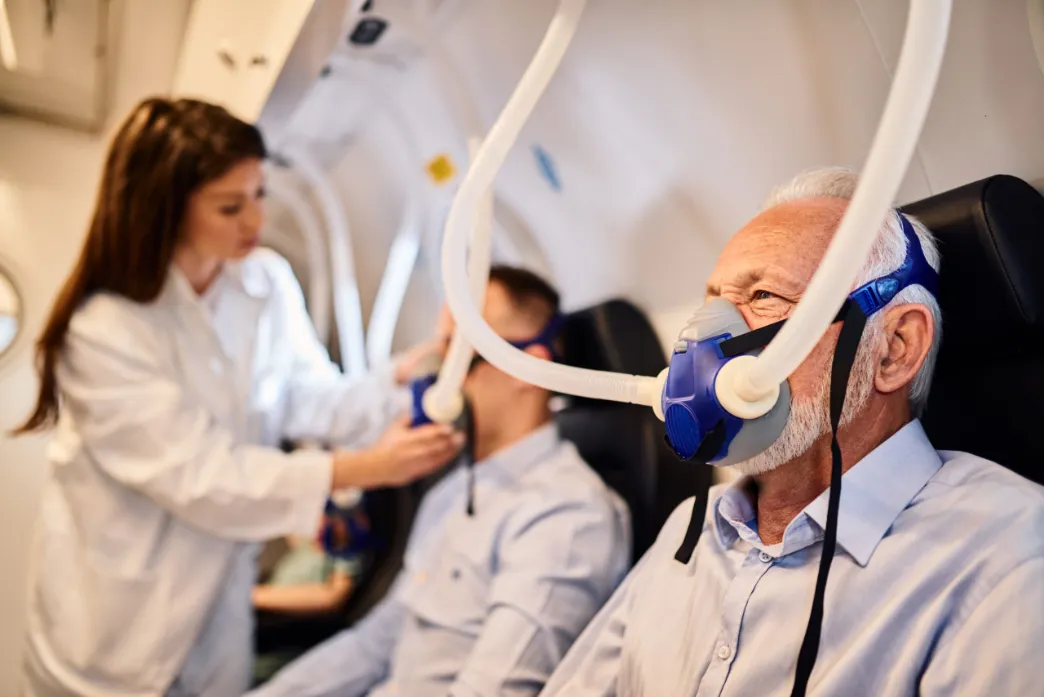A deep dive into how Topical Oxygen Therapy works and its role in speeding up the recovery process for chronic wounds. Oxygen therapy plays a vital role in wound healing, especially for chronic or non-healing wounds. Here’s how it contributes to the healing process:
1. Enhances Cellular Functions
- Oxygen and Collagen Production: Oxygen is essential for synthesizing collagen, a protein crucial for tissue repair and wound closure. Without adequate oxygen, the body struggles to produce new skin and connective tissue.
- Cell Growth: Oxygen promotes the growth of fibroblasts, which are cells responsible for generating new tissue and closing the wound. It also stimulates the formation of new blood vessels (angiogenesis), which bring more oxygen and nutrients to the wound area.
2. Reduces Risk of Infection
- Bacterial Killing: Oxygen helps white blood cells function optimally. These immune cells rely on oxygen to produce reactive oxygen species, which kill bacteria in the wound. Adequate oxygen levels reduce the risk of infections in the wound bed.
- Reduces Biofilm Formation: Oxygen therapy can disrupt bacterial biofilms, a common barrier to wound healing. Biofilms are clusters of bacteria that can form over the wound surface, preventing healing and leading to chronic infection.
3. Improves Blood Circulation
- Promotes Vasodilation: Oxygen therapy can increase blood flow to the wound site by dilating blood vessels. This enhanced circulation brings more nutrients and oxygen to the affected area, speeding up the healing process.
- Oxygen Delivery to Hypoxic Tissues: Wounds, especially those from diabetes or vascular diseases, often suffer from poor oxygenation. Oxygen therapy ensures that even tissues with compromised blood supply receive the oxygen needed for healing.
4. Speeds Healing of Chronic Wounds
- Hyperbaric Oxygen Therapy (HBOT): In some cases, oxygen therapy is delivered through hyperbaric oxygen therapy. This involves breathing pure oxygen in a pressurized chamber, which increases the amount of oxygen dissolved in the blood. This therapy has proven effective for treating chronic wounds like diabetic foot ulcers, radiation injuries, and pressure sores.
- Topical Oxygen Therapy: Oxygen can also be delivered directly to the wound through devices that release oxygen at the wound site. This method is beneficial for patients who cannot undergo HBOT.
5. Decreases Swelling and Inflammation
- Anti-inflammatory Effects: Oxygen reduces swelling around the wound, which can otherwise limit healing. It also helps clear out cellular waste and reduces the inflammatory response, allowing the body to focus on tissue repair.
6. Accelerates Healing in Diabetic and Vascular Disease Patients
- Diabetic Wounds: Patients with diabetes often have wounds that are slow to heal due to poor blood flow and oxygenation. Oxygen therapy increases the oxygen content in these wounds, speeding up the repair process.
- Peripheral Arterial Disease: For patients with vascular disease, oxygen therapy helps compensate for limited blood flow to the wound site by ensuring that the available oxygen is utilized efficiently.
Conclusion
Oxygen therapy accelerates wound healing by enhancing cellular activity, reducing the risk of infection, improving blood circulation, and promoting the body’s natural repair processes. For chronic and non-healing wounds, therapies like HBOT and topical oxygen therapy can make a significant difference in recovery time.


